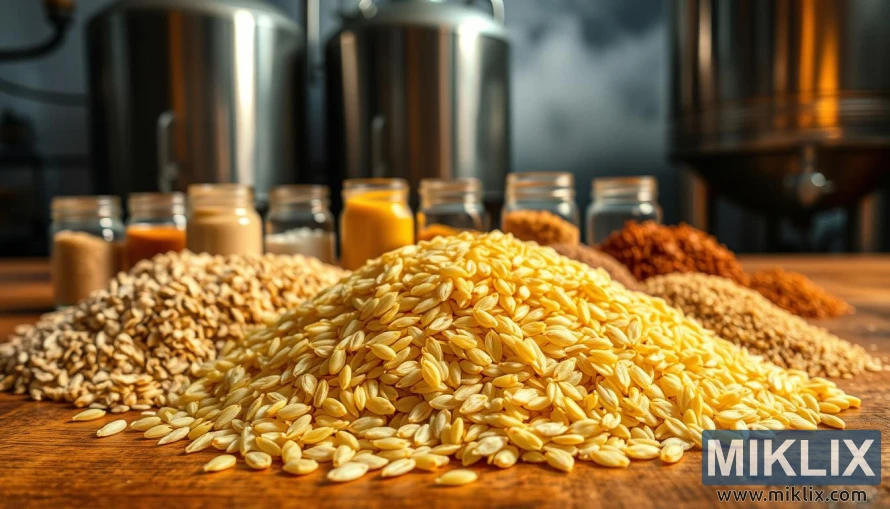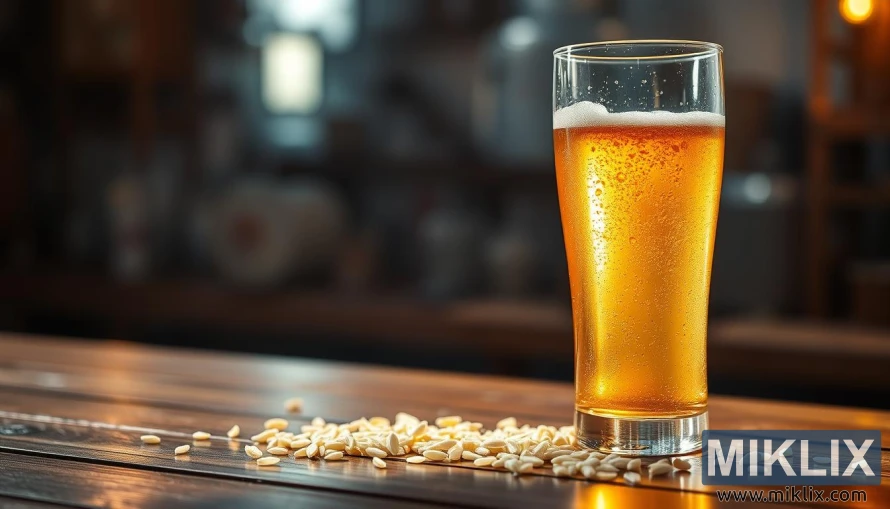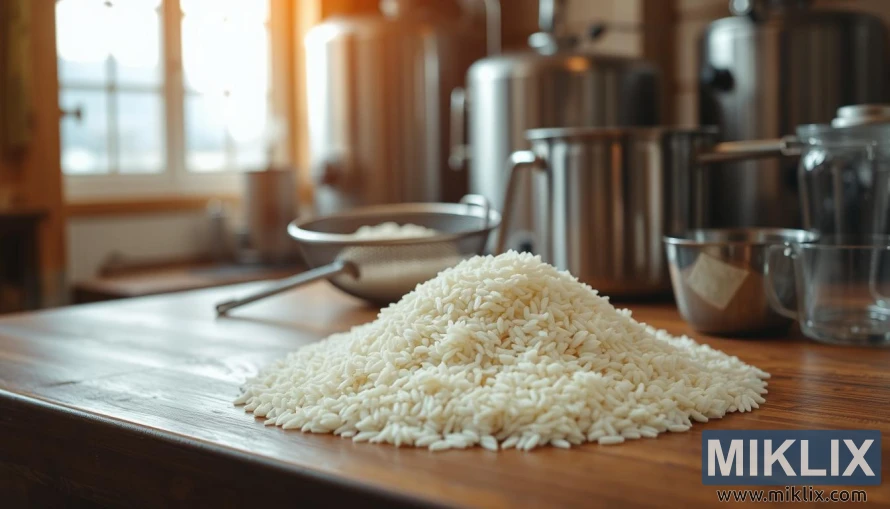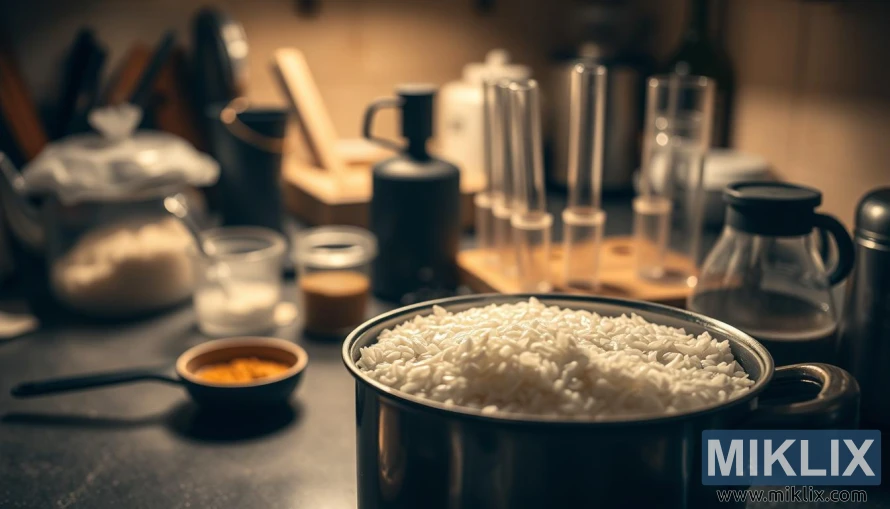Using Rice as an Adjunct in Beer Brewing
Published: July 25, 2025 at 7:50:04 AM UTC
Beer brewing has undergone a remarkable transformation over the centuries. Brewers have always strived to enhance the quality and character of their brews. The use of adjuncts, such as rice, has become increasingly popular in this pursuit. The inclusion of rice in beer brewing began in the mid-19th century. It was initially used to counter the high protein levels in 6-row barley. This innovation not only improved the beer's clarity and stability but also contributed to a lighter, cleaner taste.

Key Takeaways
- Rice has been used as an adjunct in beer brewing for over a century.
- The use of rice helps to produce a light, clean-tasting beer.
- Rice adjuncts can improve the clarity and stability of beer.
- The practice of using rice in brewing originated in the mid-19th century.
- Brewing with rice can enhance the overall character of the beer.
Understanding Rice Adjuncts in Beer Production
The history of using rice adjuncts in beer production goes back to the late 19th century. Anton Schwarz, a Bohemian brewing chemist, was the first to propose using adjuncts. He aimed to counteract the high proteins in 6-row barley.
Rice adjuncts are mixed with barley malt to create a light, clean-tasting beer. They help dilute the protein content. This makes the beer less likely to become hazy or develop off-flavors.
The benefits of using rice adjuncts in beer production are many. Some key advantages include:
- Improved beer clarity and stability
- Enhanced flavor profile with reduced protein content
- Increased brewhouse efficiency
- Better control over the final product's characteristics
Rice adjuncts are favored in certain beer styles, like American lagers. These beers are known for their crisp, clean taste. By understanding rice adjuncts, brewers can craft a variety of beers to suit different tastes.
The use of rice adjuncts also changes the brewing process. Brewers must adjust their mashing and sparging techniques. This requires a deep understanding of how rice interacts with barley malt and other ingredients.
Benefits of Adding Rice to Your Beer Recipe
Using rice as an adjunct in beer brewing brings several advantages. It reduces production costs and results in a lighter beer body. This makes brewing more efficient and enhances the flavor profile.
One key benefit is cost savings. Rice is often cheaper than barley, lowering the brewing cost. It also helps create a brighter, more refreshing beer with a lighter body. This appeals to brewers aiming for a crisp, clean-tasting beer.
The benefits of adding rice to your beer recipe can be summarized as follows:
- Reduced production costs due to the lower cost of rice compared to barley.
- Improved flavor profile with a cleaner, crisper taste.
- Increased brewing efficiency due to the characteristics of rice.
- A lighter beer body, appealing to consumers looking for a refreshing beer.
Rice also enhances the beer's overall character, making it a favorite among brewers. By adjusting the rice proportion in their recipes, brewers can tailor the flavor and body. This offers flexibility and creativity in brewing.
In conclusion, adding rice to your beer recipe offers many benefits. These include cost savings, improved flavor, and enhanced brewing efficiency. As brewers continue to explore new ingredients and techniques, rice will remain a valuable adjunct in achieving brewing excellence.

Chemical Composition of Rice in Brewing
For brewers using rice as an adjunct, grasping its chemical makeup is key. Rice is mainly starch, with proteins and lipids in smaller amounts. These components are vital in the brewing process.
The starch in rice is critical because it's a source of fermentable sugars for yeast. Rice starches gelatinize more easily than those in other grains. This makes brewing simpler.
Though proteins are less abundant, they significantly influence beer's body and foam stability. They also interact with other ingredients, shaping the beer's flavor and clarity.
Lipids, or fats, in rice can alter beer's flavor and aroma. Their impact, though small, is significant. They can lead to off-flavors if not controlled.
The chemical makeup of rice adjuncts affects the gelatinization temperature. This is essential for enzyme activity during mashing. Brewers must consider these aspects to refine their brewing techniques.
- The starch content provides fermentable sugars.
- Proteins affect the beer's body and foam.
- Lipids can impact flavor and aroma.
In summary, the chemical composition of rice is fundamental in brewing. By managing starch, protein, and lipid content, brewers can craft high-quality beers that align with their goals.
Preparing Rice for the Brewing Process
Preparing rice for brewing is a critical step that greatly affects the beer's quality. It ensures the rice enhances the beer's flavor, texture, and character.
The process of preparing rice for brewing includes several key steps. These are milling, steeping, germination, and kilning. Each step is vital for developing the rice's enzymatic capabilities and flavor.
- Milling: The first step is milling, which removes the outer husk to reveal the starchy interior.
- Steeping: Steeping involves soaking the milled rice in water to rehydrate it and activate enzymes.
- Germination: Germination follows, where the rice sprouts, breaking down starches into fermentable sugars.
- Kilning: Lastly, kilning stops germination by drying the rice, preserving enzymes and flavor compounds.
Proper rice preparation is key to achieving desired brewing outcomes. By mastering these steps, brewers can fully utilize rice as an adjunct in their recipes.

Different Forms of Rice in Brewing
Rice in brewing comes in various forms, each with its own benefits and flavor profiles. Brewers can select from these forms to tailor their beers' characteristics.
Flaked rice is a common choice, processed into thin flakes that gelatinize starches. This makes them easier for enzymes to break down during brewing. It's often used to add crispness and lightness, fitting well in American lagers.
Rice malt is another option, made by malting rice grains like barley malts. It brings a rich, complex flavor but is less common due to its higher cost and specific processing needs.
Rice syrup, a liquid adjunct, is also used. It's created by enzymatically breaking down rice starches into fermentable sugars. This simplifies brewing by reducing the need for mashing and lautering, providing directly fermentable sugars.
Choosing the right rice form depends on the beer's desired characteristics, the brewing process, and available equipment. Each form offers unique advantages, from ease of use to flavor, allowing brewers to craft specific beer styles.
Exploring different rice forms can lead to innovative beers. Understanding flaked rice, rice malt, and rice syrup's characteristics helps brewers expand their techniques and repertoire.
Impact of Rice on Beer Characteristics
Adding rice to beer brewing changes the final product's characteristics. It can make the beer lighter and brighter in color. This is why many brewers choose rice for a crisp, refreshing taste.
Rice also affects the flavor of beer. It reduces maltiness, giving a cleaner, more neutral taste. This is great for brewers wanting a beer with a subtle flavor.
Using rice in brewing can also improve beer clarity and foam stability. But, brewers need to balance rice with other ingredients carefully. This ensures the beer meets their desired characteristics.
Understanding rice's impact on beer allows brewers to make better choices in their recipes. Whether they're aiming for a traditional style or something new, rice can be a key ingredient.
Calculating Rice Proportions in Your Recipe
The right amount of rice in your grain bill is key to your beer's flavor. Getting it right is critical. In the past, brewers often used 10 to 20% adjuncts, a common practice before Prohibition.
To get rice proportions right, you must think about your grain bill's overall impact. Rice can lighten the beer's body and flavor. This makes it a favorite for many beer styles.
When figuring out rice amounts, mash temperature is also important. It influences how easily the wort ferments. A well-thought-out rice ratio can result in a beer with a smoother, more balanced taste.
- Think about the beer style you're aiming for and how rice will change its character.
- Understand how rice fits into your grain bill and its role in the beer's flavor.
- Adjust your mash temperature to get the fermentability you want.
By carefully planning rice proportions and their effects on brewing, you can craft unique, flavorful beers. These beers will surely catch the eye of beer enthusiasts.
Common Brewing Styles Using Rice
Brewing styles that incorporate rice are varied, spanning from crisp lagers to refreshing pale ales. Rice's versatility allows it to enhance different beer styles, creating unique flavor profiles and characteristics.
Lager is a prevalent brewing style that benefits from rice. Rice adjuncts in lager brewing contribute to a cleaner, crisper taste. This is why Asian lagers often use rice, resulting in a dry, refreshing taste.
Pilsner is another style frequently using rice. Pilsners made with rice have a lighter body and a more delicate flavor than those without. This makes the beer refreshing and easy to drink.
Pale ale also benefits from rice. While less common than lager or pilsner, rice can add a unique character to pale ales. It helps balance hop flavors and smoothens the mouthfeel.
The characteristics of beers brewed with rice vary greatly. This depends on the rice proportion and brewing techniques used. Brewers can experiment with different rice forms and methods to achieve desired flavors.
- Lagers: Crisp, clean flavor profiles
- Pilsners: Light body, delicate flavor
- Pale Ales: Balanced hop flavors, smooth mouthfeel
In conclusion, rice is a valuable ingredient in brewing, allowing for a wide range of beer styles. By understanding rice's impact on brewing, brewers can create unique and delicious beers.

Step-by-Step Rice Addition Process
The process of adding rice to beer brewing involves several key steps. Brewers must follow these steps carefully.
First, brewers prepare the rice for mashing by milling or flaking it. This step is critical. It affects how well the rice mixes with other grains and how efficiently enzymes break down starches into fermentable sugars.
Once the rice is prepared, it is added to the mash tun with other grains. The mashing process soaks the grains in hot water. This activates enzymes to break down starches. The temperature and pH of the mash are key factors brewers must control for optimal enzyme activity.
After mashing, brewers sparge the grains to extract sugars. The resulting liquid, known as wort, is then boiled with hops. This adds bitterness, flavor, and aroma. The boiling process also sterilizes the wort and coagulates proteins that could cause haze in the finished beer.
To summarize, the key steps in the rice addition process are:
- Preparing the rice for mashing
- Mashing the rice with other grains
- Sparging to extract sugars
- Boiling the wort with hops
By following these steps carefully, brewers can successfully incorporate rice into their beer recipes. They can achieve the desired characteristics in their finished beers.
Troubleshooting Rice-Based Brewing Issues
Brewing with rice can be complex, and troubleshooting common issues is key to achieving optimal results. When using rice as an adjunct, brewers may face problems that impact the final product's quality. It's essential to understand these issues and find solutions to produce high-quality beer.
One common issue in brewing with rice is hot-side aeration. This occurs when oxygen is introduced into the wort during brewing, potentially causing off-flavors and staling. To reduce hot-side aeration, brewers can take several steps:
- Use a closed system for brewing to prevent oxygen from entering the wort.
- Monitor the brewing process to identify any oxygen entry points.
- Implement techniques such as blanketing the wort with inert gas to prevent oxidation.
Another issue brewers may face is related to sparge-water pH. The pH of the sparge water can significantly impact brewing, as high pH levels can extract unwanted compounds from grains. To address this, brewers can:
- Test the pH of the sparge water to ensure it's within the optimal range.
- Adjust the pH of the sparge water as needed using acids or other treatments.
- Monitor the brewing process to ensure the pH remains stable.
Besides hot-side aeration and sparge-water pH, brewers may encounter other issues with rice adjuncts. These can include problems with mash temperature, lautering, and fermentation. By understanding these issues and implementing effective solutions, brewers can optimize their brewing process and produce high-quality beer.

Equipment Needed for Brewing with Rice
Rice brewing requires specific equipment for the best results. The quality and type of gear used greatly affect the beer's taste, clarity, and character.
Several essential pieces are needed for brewing beer with rice. These include mash tuns, kettles, and fermenters. Mash tuns are used for mashing grains and rice adjuncts. This process breaks down starches into fermentable sugars.
Kettles are vital for boiling the wort. Here, hops are added for bitterness, flavor, and aroma. The kettle's size and material matter, with larger ones allowing for bigger batches. Stainless steel kettles are durable and easy to clean.
Fermenters are where the magic happens. Yeast ferments the sugars into alcohol and carbon dioxide. The fermenter's material and design impact fermentation. Some brewers prefer conical fermenters for easier yeast harvesting and less contamination risk.
Having the right equipment is not just about individual parts. It's about how they work together to make high-quality beer. Proper maintenance and sanitation of equipment are also key. They prevent contamination and ensure consistent results.
Best Practices for Rice Storage and Handling
To achieve the best brewing results, it's vital to adhere to best practices for storing and handling rice. Proper storage and handling are essential for maintaining rice quality. This quality directly affects the brewing process.
Moisture control is a key factor in rice storage. Rice must be kept in a dry environment to avoid moisture absorption. This can cause mold growth and spoilage. It's advisable to store rice in airtight containers to keep the atmosphere dry.
Pest management is another critical aspect of rice handling. Rice is vulnerable to pests like insects and rodents. These can contaminate the rice and degrade its quality. Regular inspections and proper sealing of storage containers can help prevent pest infestations.
Here are some best practices to follow for rice storage and handling:
- Store rice in a cool, dry place away from direct sunlight.
- Use airtight containers to prevent moisture and pest entry.
- Regularly inspect rice for signs of spoilage or pest infestation.
- Keep the storage area clean and free from debris.
By adhering to these best practices, brewers can ensure their rice remains in optimal condition. This, in turn, contributes to a superior brewing outcome.
Commercial Examples of Rice-Based Beers
Many renowned breweries have incorporated rice into their brewing processes, resulting in a diverse range of rice-based beers. This practice is not new, but its popularity has grown as breweries seek to innovate and differentiate their products. The use of rice as an adjunct can significantly impact the flavor, clarity, and overall character of the beer.
Several well-known breweries have successfully integrated rice into their brewing recipes. For instance, some Japanese breweries are famous for their rice-based lagers, which are crisp and refreshing. In the United States, certain craft breweries have also experimented with rice, creating unique beers that appeal to a wide range of consumers.
Rice-based beers are often characterized by their light flavor and clean finish. The use of rice can help to reduce the beer's body and enhance its drinkability. To produce these beers, breweries typically use a combination of rice and traditional brewing ingredients, adjusting their brewing processes to accommodate the characteristics of rice.
Some common characteristics of rice-based beers include:
- Light and crisp flavor profile
- Clean finish
- Enhanced drinkability
- Potential for reduced calorie count compared to traditional beers
The incorporation of rice in commercial beer brewing has led to the development of a unique category of beers that are appreciated for their distinct characteristics. As the brewing industry continues to evolve, it will be interesting to see how rice-based beers adapt and grow in popularity.
Conclusion
Rice has become a key ingredient in beer brewing, opening up a world of possibilities for brewers. It allows them to craft a wide array of beer styles. The inclusion of rice can greatly affect the flavor, texture, and overall character of the beer.
The benefits of using rice in brewing are numerous. Its chemical makeup and preparation methods have been thoroughly examined. By mastering the use of rice, brewers can enhance their creativity and produce beers that appeal to a broad audience.
The brewing industry is constantly evolving, and rice's role in brewing is expected to expand further. With the right techniques and knowledge, brewers can create innovative and delicious beers. Whether you're an experienced brewer or just starting, using rice can be a rewarding experience.
By embracing rice in brewing, brewers can explore new horizons in traditional beer styles. This leads to the creation of exciting and unique flavors. As the craft brewing community delves deeper into rice's possibilities, the future of brewing looks incredibly promising.
Further Reading
If you enjoyed this post, you may also like these suggestions:
- Using Maize (Corn) as an Adjunct in Beer Brewing
- Using Roasted Barley in Beer Brewing
- Using Honey as an Adjunct in Beer Brewing
